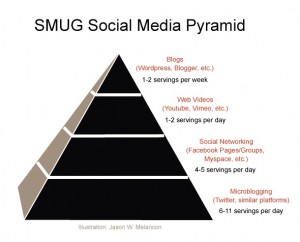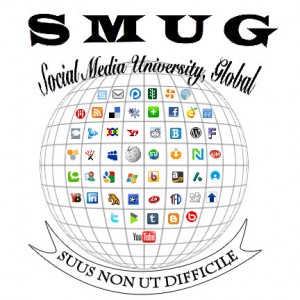Despite the decidedly social media nature of SMUG (“social media” is part of our name, after all), I’m still a big believer in books. They enable authors to make an extended argument and deal with a topic in more depth than the blog format allows.
I’ve written several book reviews here on SMUG, but it’s time for me to catch up, based on several more I’ve read or listened to via Audible.com. And I thought it would be helpful to develop a more comprehensive list of books that receive the SMUG Seal of Approval. As soon as I’ve finished adding related reviews and links to this post, I will be using it as the basis for a remodeled SMUG Bookstore.
Of course, everything about SMUG is voluntary, and tuition is free, so I can’t really say these are “required reading” for SMUGgles. As I get the reviews done, I will add links to the list of SMUG textbooks below. And if you have recommendations of books I’ve missed that you think would be helpful, please add them in the comments.
Personal Productivity
- Getting Things Done: The Art of Stress-Free Productivity
, by David Allen. GTD-related posts were among the earliest subjects of this blog in the pre-SMUG days, but the life lessons are clearly applicable for SMUGgles. Buy the book here.
- The 4-Hour Workweek, by Timothy Ferris
Social Media Theory and Philosophy
- Groundswell, by Charlene Li and Josh Bernoff
- Here Comes Everybody: The Power of Organizing Without Organizations, by Clay Shirky
- Trust Agents: Using the Web to Build Influence, Improve Reputation, and Earn Trust, by Chris Brogan and Julien Smith
- What Would Google Do?, by Jeff Jarvis
- Wikinomics, by Don Tapscott and Anthony D. Williams
- Made to Stick, by Chip Heath and Dan Heath
- Twitterville, by Shel Israel
- The Corporate Blogging Book, by Debbie Weil
Business and Innovation
- The Innovator’s Dilemma, by Clayton Christensen
- The Innovator’s Solution, by Clayton Christensen
- Our Iceberg is Melting, by John Kotter
- Death by Meeting, by Patrick Lencioni
- Blue Ocean Strategy, by W. Chan Kim and Renee Mauborgne
- Free: The Future of a Radical Price, by Chris Anderson. You can download this for free if you have an Audible.com account.
- Seeing What’s Next, by Clayton Christensen
- Rules to Break and Laws to Follow, by Don Peppers and Martha Rogers
- The Wisdom of Crowds, by James Surowiecki
- Selling the Dream, by Guy Kawasaki
The Gladwell Grouping
Malcolm Gladwell’s books defy easy categorization, but he has a wonderful writing style and has a thought-provoking approach to all sorts of topics. If he wrote it, you should read it.
- Outliers, by Malcolm Gladwell
- Blink! The Power of Thinking without Thinking, by Malcolm Gladwell
- The Tipping Point, by Malcolm Gladwell
- What the Dog Saw, by Malcolm Gladwell
The Seth Section
Like Gladwell, Seth Godin deserves a section of his own. These are all somewhat related to marketing, particularly as it is understood as designing delivery of your products or services in a way that enhances customer satisfaction and word-of-mouth.
- Tribes, by Seth Godin
- Purple Cow, by Seth Godin
- Free Prize Inside, by Seth Godin
- Meatball Sundae, by Seth Godin
- The Dip, by Seth Godin
- Small is the New Big, by Seth Godin







